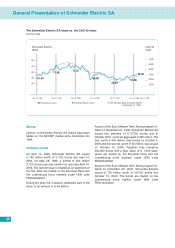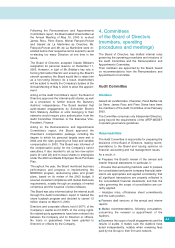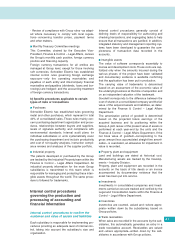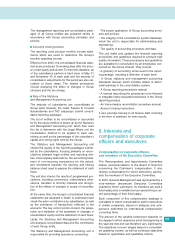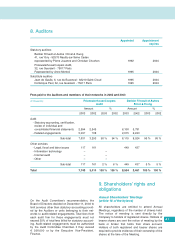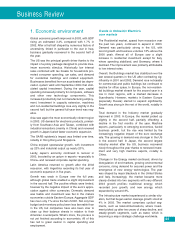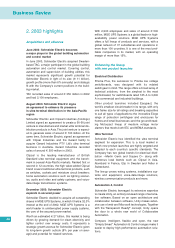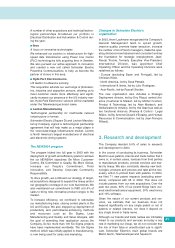APC 2003 Annual Report Download - page 37
Download and view the complete annual report
Please find page 37 of the 2003 APC annual report below. You can navigate through the pages in the report by either clicking on the pages listed below, or by using the keyword search tool below to find specific information within the annual report.
5. Internal Control
Internal Control Objectives
Over the last fifteen years, Schneider Electric has
built a position as one of the world's leading
Electrical Distribution and Automation & Control
companies by acquiring firms specialized in these
core businesses and divesting others that no longer
fit its strategy.
To anticipate and control the risks associated with its
operations, as well as the risk of accounting and
other errors and fraud, procedures have been estab-
lished at Group level that support the acquired enti-
ties' procedures.
The purpose of these procedures is to:
■Ensure that management actions, transactions and
employee behavior are consistent with the overall
business strategy decided by the Board of Directors
of Schneider Electric SA, the Group's parent compa-
ny, that they comply with the applicable laws and reg-
ulations and that they reflect the Group's values and
internal standards and rules.
■Obtain assurance that statutory and management
accounting data presented to the Board of Directors
of Schneider Electric SA and the Executive Commit-
tee present fairly the sales, results of operations and
financial position of the Group.
No system of internal control designed to fulfill the
above objectives is capable of providing absolute
assurance that the objectives will be met due to the
inherent limitations of procedures, however well con-
ceived.
Internal Control Organization
Key participants
a) Board of Directors, Audit Committee and
Remunerations and Appointments Committee
Article L.225-35 of the Commercial Code states that
the Board of Directors is responsible for determining
the Company's business strategy and overseeing its
implementation. In this oversight capacity, the Board
of Directors participates in Schneider Electric’s sys-
tem of internal control.
The control exercised by the Board of Directors pri-
marily extends across the following areas:
■Implementation of Group strategy. Under the
Board's internal rules limiting the powers of the Chief
Executive Officer, the prior approval of the Board is
required for all material transactions (defined as
transactions in excess of € 100 million).
■The annual and interim financial statements, which
are approved or reviewed by the Board of Directors.
Prior to their submission to the Board of Directors,
the financial statements are reviewed by the Audit
Committee which reports its conclusions to the
Board. The main purpose of the Audit Committee's
review is to obtain assurance as to whether the
accounting policies used are appropriate and have
been applied consistently from one period to the
next, whether transactions that are material at Group
level have been properly accounted for and whether
the rules governing the inclusion of companies in the
scope of consolidation have been properly applied.
■The reliability of the internal control system. The
Audit Committee reports to the Board of Directors on
its review of the internal audit organization, programs
and findings, as well as on any examination of finan-
cial or accounting risk management issues per-
formed at the Committee's own initiative or at the
request of the Board of Directors or the Chairman.
■Executive compensation and stock options. The
Remunerations and Appointments Committee
makes recommendations to the Board of Directors
concerning the Chairman and Chief Executive
Officer's compensation package and on manage-
ment stock option plans. The Committee also reports
to the Board about senior management compensa-
tion policies applied within the Group.
b) General Management
In 2003, the Executive Committee comprised Henri
Lachmann, Chairman and Chief Executive Officer,
the Executive Vice-Presidents of the North
American, European and International Divisions, and
the Executive Vice-Presidents in charge of the
Corporate Divisions (Strategy & Market Develop-
ment, Developments–Industry) and Corporate
Functions (Finance & Control – Legal Affairs, and
Human Resources & Communication). The Executive
Committee meets once a month to review business
performance (order intake, billings) and the status of
action plans (to increase sales, cut costs, etc.) drawn
up by the various units. These meetings also provide
an opportunity to discuss strategic issues, such as
the positioning of the product lineup, relations with
partners and distributors, supply chain organization
and R&D policy.
At the beginning of 2004, following the appointment of
a Chief Operating Officer, the Executive Committee
was replaced by two new structures, the Direction and
Strategy Committee and the Acquisitions Committee.
c) Internal Audit
The Vice-President in charge of the 15-member
Internal Audit Department reports to the Chairman
and CEO and to the Audit Committee.
35



